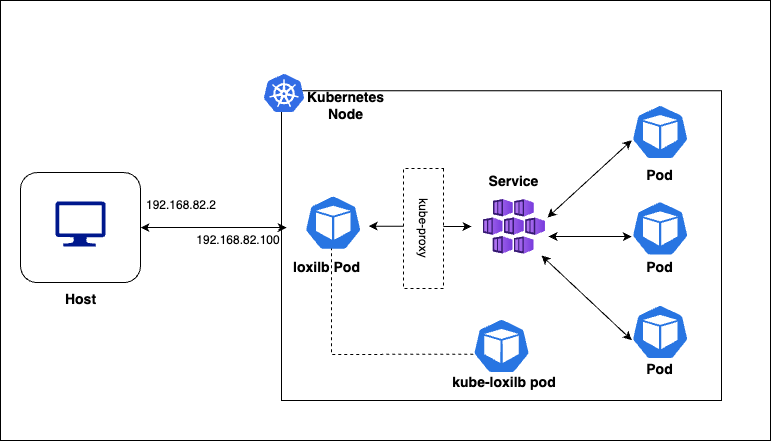Quick Start Guide with K0s and LoxiLB in-cluster mode
This document will explain how to install a K0s cluster with loxilb as a serviceLB provider running in-cluster mode.
Prerequisite(s)
- Single node with Linux
Topology
For quickly bringing up loxilb in-cluster and K0s, we will be deploying all components in a single node :

loxilb and kube-loxilb components run as pods managed by kubernetes in this scenario.
Setup k0s in a single-node
# k0s installation steps
curl -sSLf https://get.k0s.sh | sudo sh
sudo k0s install controller --single
sudo k0s start
Check k0s status
$ sudo k0s status
Version: v1.29.2+k0s.0
Process ID: 2631
Workloads: true
SingleNode: true
Kube-api probing successful: true
Kube-api probing last error:
How to deploy loxilb ?
loxilb can be deloyed by using the following command in the K3s node
sudo k0s kubectl apply -f https://raw.githubusercontent.com/loxilb-io/loxilb/main/cicd/k0s-incluster/loxilb.yml
How to deploy kube-loxilb ?
kube-loxilb is used as an operator to manage loxilb.
wget https://raw.githubusercontent.com/loxilb-io/loxilb/main/cicd/k0s-incluster/kube-loxilb.yml
kube-loxilb.yaml
args:
#- --loxiURL=http://172.17.0.2:11111
- --externalCIDR=192.168.82.100/32
- --setRoles=0.0.0.0
#- --monitor
#- --setBGP
In the above snippet, loxiURL is commented out which denotes to utilize in-cluster mode to discover loxilb pods automatically. External CIDR represents the IP pool from where serviceLB VIP will be allocated.
Apply after making changes (if any) :
sudo k0s kubectl apply -f kube-loxilb.yaml
Create the service
sudo k0s kubectl apply -f https://raw.githubusercontent.com/loxilb-io/loxilb/main/cicd/k0s-incluster/tcp-svc-lb.yml
Check status of various components in k0s node
In k0s node:
## Check the pods created
$ sudo k0s kubectl get pods -A
NAMESPACE NAME READY STATUS RESTARTS AGE
kube-system kube-proxy-vczxm 1/1 Running 0 4m48s
kube-system kube-router-gjp7g 1/1 Running 0 4m48s
kube-system metrics-server-7556957bb7-25hsk 1/1 Running 0 4m50s
kube-system coredns-6cd46fb86c-xllg2 1/1 Running 0 4m50s
kube-system loxilb-lb-4fmdp 1/1 Running 0 3m43s
kube-system kube-loxilb-6f44cdcdf5-ffdcv 1/1 Running 0 2m22s
default tcp-onearm-test 1/1 Running 0 92s
## Check the services created
$ sudo k0s kubectl get svc
NAME TYPE CLUSTER-IP EXTERNAL-IP PORT(S) AGE
kubernetes ClusterIP 10.96.0.1 <none> 443/TCP 5m28s
tcp-lb-onearm LoadBalancer 10.96.108.109 llb-192.168.82.100 56002:32033/TCP 111s
In loxilb pod, we can check internal LB rules:
$ sudo k0s kubectl exec -it -n kube-system loxilb-lb-4fmdp -- loxicmd get lb -o wide
| EXT IP | SEC IPS | PORT | PROTO | NAME | MARK | SEL | MODE | ENDPOINT | EPORT | WEIGHT | STATE | COUNTERS |
|----------------|---------|-------|-------|-----------------------|------|-----|--------|-----------|-------|--------|--------|----------|
| 192.168.82.100 | | 56002 | tcp | default_tcp-lb-onearm | 0 | rr | onearm | 10.0.2.15 | 32033 | 1 | active | 25:1842 |
Connect from host/client
$ curl http://192.168.82.100:56002
<!DOCTYPE html>
<html>
<head>
<title>Welcome to nginx!</title>
<style>
html { color-scheme: light dark; }
body { width: 35em; margin: 0 auto;
font-family: Tahoma, Verdana, Arial, sans-serif; }
</style>
</head>
<body>
<h1>Welcome to nginx!</h1>
<p>If you see this page, the nginx web server is successfully installed and
working. Further configuration is required.</p>
<p>For online documentation and support please refer to
<a href="http://nginx.org/">nginx.org</a>.<br/>
Commercial support is available at
<a href="http://nginx.com/">nginx.com</a>.</p>
<p><em>Thank you for using nginx.</em></p>
</body>
</html>
For more detailed information on incluster deployment of loxilb with bgp in a full-blown cluster, kindly follow this blog.
All of the above steps are also available as part of loxilb CICD workflow. Follow the steps below to replicate the above (please note that you will need vagrant tool installed to run:
$ git clone https://github.com/loxilb-io/loxilb.git
$ cd cicd/k0s-incluster/
# To setup the single node k0s setup with kube-router networking and loxilb as external load balancer
$ ./config.sh
# To validate the results
$ ./validation.sh
# To login to the node and check the installation
$ vagrant ssh k0s-node1
# Cleanup
$ ./rmconfig.sh